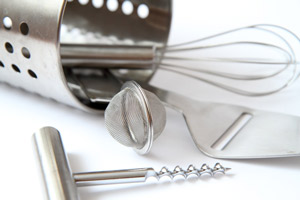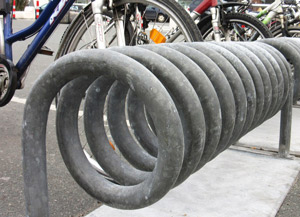
Zinc alloys and stainless steel are common materials used for parts in many applications. Choosing zinc alloys vs. stainless steel as a material would depend on the specific applications each alloy is best suited for (this includes the casting of each alloy). The finished product will have its own mechanical and physical properties that determine its longevity, durability, strength, and overall functionality.
The casting process of any alloy involves injecting molten metal into a mold, or die, under high pressure to produce a particular shape. The process is ideal for manufacturing of high volume parts because of its dimensional accuracy, intricate detailing, and the ability to produce highly complex geometries. Choosing zinc alloys vs. stainless steel will ultimately be determined by such factors as volume, costs, usage, and size, among other reasons determined by the marketplace.
Stainless Steel
 Choosing stainless steel as an application over a zinc alloy will depend on a company’s needs. Stainless steel is an alloy of iron, carbon, and a minimum of 10.5% chromium known for its strength and corrosion resistance. It comes in many different grades that are determined by the degree and combination of elements mixed with the iron, carbon, and chromium. Modern stainless steel may contain such elements as nickel, niobium, molybdenum, and titanium to boost corrosion resistance, add strength and ductility to weather environmental factors that are found in climates ranging from tropical, dry, temperate, cold and polar found on land and sea, and even in the upper atmosphere and outer space.
Choosing stainless steel as an application over a zinc alloy will depend on a company’s needs. Stainless steel is an alloy of iron, carbon, and a minimum of 10.5% chromium known for its strength and corrosion resistance. It comes in many different grades that are determined by the degree and combination of elements mixed with the iron, carbon, and chromium. Modern stainless steel may contain such elements as nickel, niobium, molybdenum, and titanium to boost corrosion resistance, add strength and ductility to weather environmental factors that are found in climates ranging from tropical, dry, temperate, cold and polar found on land and sea, and even in the upper atmosphere and outer space.
Stainless Steel Applications
The most familiar type of stainless steel is Type 304, or simply, 304. An austenitic stainless steel grade, it has a wide variety of industrial applications. Primary uses are for architectural paneling, kitchen equipment like pots, pans and cutlery, along railings, and also for the manufacture of springs, or marine equipment.
Comparatively, if your needs require exceptional toughness against corrosion with very excellent welding capabilities, then 316 stainless steel grade would be your prime choice. This includes, boat fittings, jet engine parts, coastal architecture, or water filtration screens.
Stainless Steel Pros
- Strong
- Durable
- Corrosion resistant
- Rust proof
- Aesthetically pleasing
Stainless Steel Cons
-
- Expensive
- High tooling cost
- Difficult to make larger items
Zinc
 Zinc is rarely used in its pure form but instead is used to form numerous metal casting alloys, including brass, bronze, nickel silver, soft solder, German silver, spring brass, and aluminum solder. Popular zinc alloys are referred to by the acronym ZAMAK, for zinc, aluminum, magnesium and copper.
Zinc is rarely used in its pure form but instead is used to form numerous metal casting alloys, including brass, bronze, nickel silver, soft solder, German silver, spring brass, and aluminum solder. Popular zinc alloys are referred to by the acronym ZAMAK, for zinc, aluminum, magnesium and copper.
Probably the best known alloy of zinc is brass, which is made by adding 55% or more copper to zinc. Brass is commonly used today for its corrosion resistance. When zinc is exposed to air it naturally reacts to the carbon dioxide in it and forms a layer of zinc carbonate. This layer acts as a protective coating from further reactions with air or water, which is why roughly one third of all metallic zinc produced today is used to galvanize other metals to prevent corrosion.
Zinc Applications
From outlets to radiators to nails, zinc casting is commonly used to make electrical, automotive, and hardware equipment. Due to decreased cost, zinc alloys are often the choice for larger items where a higher volume of materials is required to make a part.
Zinc Pros
- Durable
- Cost efficient
- Corrosion resistant
- Rust Proof
- Can be galvanized onto other metals
- Versatile (can be mixed into different alloys)
Zinc Cons
- Less aesthetically pleasing
- Slightly less strong
Choosing Between Zinc Alloys and Stainless Steel
When comparing the two alloys per cost, the price of stainless steel is more because of its chromium content. Zinc is cheaper than chromium, and therefore, in general, zinc alloys are relatively less expensive than compared to stainless steel. Though more expensive, stainless steel is a strong, tough material noted for its corrosion resistance. Though some Zinc alloys can be very strong, overall stainless steel is stronger. However, zinc is a heavy element, and when alloyed with other metals it provides better corrosion resistance, stability, dimensional strength and impact strength. Because of a lower casting temperature, zinc provides a much longer die life which further adds to reducing production costs. When it comes to casting components with tight tolerances and areas with thinner wall sections, no other alloys compare to the zinc alloys.
Ultimately, which alloy to use will depend on your casting needs. In general, due to differences in cost zinc is usually preferred for larger items where aesthetics are less important (outdoor equipment) while stainless steel is most often used for smaller items where aesthetics matter (indoor use and decor).














